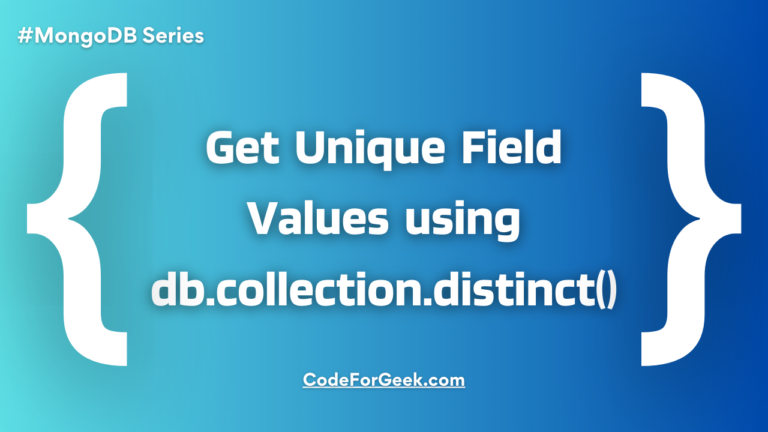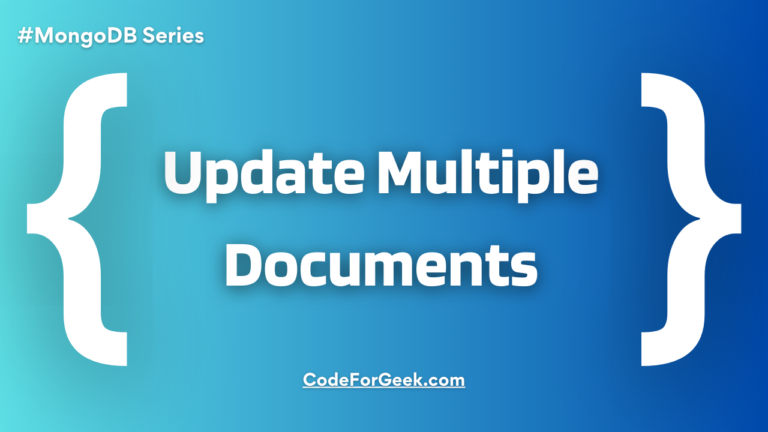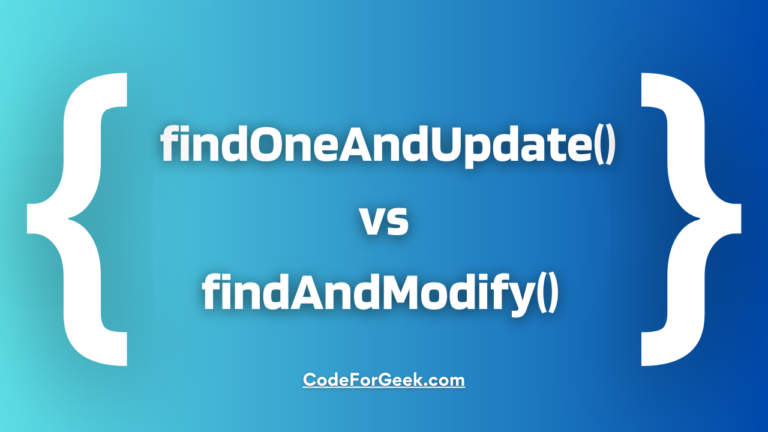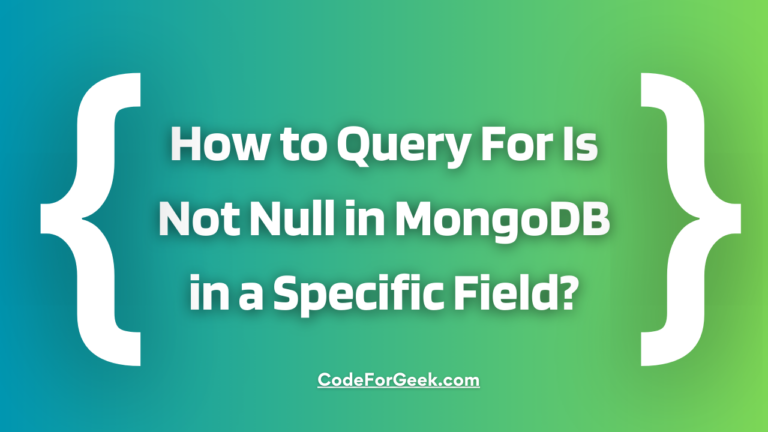In this tutorial, I will explain the $slice modifier in MongoDB.
The $slice modifier will help us limit the number of elements to insert when we conduct a $push operation. The $slice modifier must be used in conjunction with the $each operator. Only the $slice modifier has an impact if you give an empty array [] to the $each operator.
This guide will give several examples of using the $slice modifier in MongoDB. So, let us get started.
The $slice Modifier in MongoDB Syntax
Let us take a look at the syntax of the $slice modifier in MongoDB:
{
$push: {
field: {
$each: [ value1, value2, ... ],
$slice: num
}
}
}
Using the $slice Modifier in MongoDB
Let us begin our discussion of the various examples that I want to cover using the $slice modifier in MongoDB.
Slicing an Array Field from the End Using the $slice Modifier
- Start up the Mongo local database server
- Choose and navigate into a database you want to work in using the use db_name command in the mongo shell
- Let us take a look at all the documents available to us in the drones collections in the droneStore database:
> use droneStore
switched to db droneStore
Viewing Existing Documents in the Collection
> db.drones.find({}).pretty()
{
"_id" : ObjectId("61673f46b34f185eb7b2bf0c"),
"utility" : [
"Videography",
"Combat",
"Rescue",
"Construction"
],
"onSale" : false,
"name" : "Nimbari Gryphon Medeta 65",
"price" : 77500,
"weight" : "77 kilograms",
"additionalDetails" : {
"material" : "carbon fiber",
"moreUses" : [
"Delivery",
"Monitoring or Inspection",
"Recreation"
]
}
}
{
"_id" : ObjectId("61673f46b34f185eb7b2bf0d"),
"utility" : [
"Videography",
"Combat",
"Rescue",
"Construction"
],
"onSale" : false,
"name" : "X-Strimmer Eye",
"price" : 23500,
"weight" : "24 kilograms",
"additionalDetails" : {
"material" : "glass fiber",
"moreUses" : [
"Land Inspection",
"Water Inspection"
]
}
}
{
"_id" : ObjectId("61673f46b34f185eb7b2bf0e"),
"utility" : [
"Delivery",
"Combat",
"Rescue",
"Construction"
],
"onSale" : false,
"name" : "Khai Balemosh Shefqa TRX",
"price" : 120500,
"weight" : "80 kilograms",
"additionalDetails" : {
"material" : "aluminum",
"moreUses" : [
"Monitoring or Inspection",
"Land Inspection"
]
}
}
{
"_id" : ObjectId("61673f46b34f185eb7b2bf0f"),
"utility" : [
"Photography",
"Combat",
"Rescue",
"Construction"
],
"onSale" : false,
"name" : "Sifinist Croma AX",
"price" : 99500,
"weight" : "97 kilograms",
"additionalDetails" : {
"material" : "lithium",
"moreUses" : [
"Videography",
"Water Inspection"
]
}
}
{
"_id" : ObjectId("61673f46b34f185eb7b2bf10"),
"utility" : [
"Security",
"Combat",
"Rescue",
"Construction"
],
"onSale" : false,
"name" : "Drovce Finnifield FR-7",
"price" : 87600,
"weight" : "13 kilograms",
"additionalDetails" : {
"material" : "polysterene",
"moreUses" : [
"Land Inspection",
"Videography"
]
}
}
Slicing Documents from the End
- We will now use the $slice modifier to trim the utility array to the last 5 items. We will set the value as -5 because we want to trim values from the end of the array:
> db.drones.updateMany( { }, { $push : { utility : { $each : [ "Cinematography", "Range-finding Photography" ], $slice : -5 } } } )
{ "acknowledged" : true, "matchedCount" : 5, "modifiedCount" : 5 }
- Let us now check our documents:
> db.drones.find({}).pretty()
{
"_id" : ObjectId("61673f46b34f185eb7b2bf0c"),
"utility" : [
"Combat",
"Rescue",
"Construction",
"Cinematography",
"Range-finding Photography"
],
"onSale" : false,
"name" : "Nimbari Gryphon Medeta 65",
"price" : 77500,
"weight" : "77 kilograms",
"additionalDetails" : {
"material" : "carbon fiber",
"moreUses" : [
"Delivery",
"Monitoring or Inspection",
"Recreation"
]
}
}
{
"_id" : ObjectId("61673f46b34f185eb7b2bf0d"),
"utility" : [
"Combat",
"Rescue",
"Construction",
"Cinematography",
"Range-finding Photography"
],
"onSale" : false,
"name" : "X-Strimmer Eye",
"price" : 23500,
"weight" : "24 kilograms",
"additionalDetails" : {
"material" : "glass fiber",
"moreUses" : [
"Land Inspection",
"Water Inspection"
]
}
}
{
"_id" : ObjectId("61673f46b34f185eb7b2bf0e"),
"utility" : [
"Combat",
"Rescue",
"Construction",
"Cinematography",
"Range-finding Photography"
],
"onSale" : false,
"name" : "Khai Balemosh Shefqa TRX",
"price" : 120500,
"weight" : "80 kilograms",
"additionalDetails" : {
"material" : "aluminum",
"moreUses" : [
"Monitoring or Inspection",
"Land Inspection"
]
}
}
{
"_id" : ObjectId("61673f46b34f185eb7b2bf0f"),
"utility" : [
"Combat",
"Rescue",
"Construction",
"Cinematography",
"Range-finding Photography"
],
"onSale" : false,
"name" : "Sifinist Croma AX",
"price" : 99500,
"weight" : "97 kilograms",
"additionalDetails" : {
"material" : "lithium",
"moreUses" : [
"Videography",
"Water Inspection"
]
}
}
{
"_id" : ObjectId("61673f46b34f185eb7b2bf10"),
"utility" : [
"Combat",
"Rescue",
"Construction",
"Cinematography",
"Range-finding Photography"
],
"onSale" : false,
"name" : "Drovce Finnifield FR-7",
"price" : 87600,
"weight" : "13 kilograms",
"additionalDetails" : {
"material" : "polysterene",
"moreUses" : [
"Land Inspection",
"Videography"
]
}
}
You can see all the documents’ utility array fields have just 5 elements even though we inserted 2 elements while they already had 4.
Slicing an Array Field from the Start Using the $slice Modifier
We will now trim arrays from the start by 6 elements this time using the $slice modifier in MongoDB.
> db.drones.updateMany( { }, { $push : { utility : { $each : [ "Wildlife Monitoring", "Precision Agriculture" ], $slice : 6 } } } )
{ "acknowledged" : true, "matchedCount" : 5, "modifiedCount" : 5 }
- Let us take a quick look at our documents now:
> db.drones.find({}).pretty()
{
"_id" : ObjectId("61673f46b34f185eb7b2bf0c"),
"utility" : [
"Combat",
"Rescue",
"Construction",
"Cinematography",
"Range-finding Photography",
"Wildlife Monitoring"
],
"onSale" : false,
"name" : "Nimbari Gryphon Medeta 65",
"price" : 77500,
"weight" : "77 kilograms",
"additionalDetails" : {
"material" : "carbon fiber",
"moreUses" : [
"Delivery",
"Monitoring or Inspection",
"Recreation"
]
}
}
{
"_id" : ObjectId("61673f46b34f185eb7b2bf0d"),
"utility" : [
"Combat",
"Rescue",
"Construction",
"Cinematography",
"Range-finding Photography",
"Wildlife Monitoring"
],
"onSale" : false,
"name" : "X-Strimmer Eye",
"price" : 23500,
"weight" : "24 kilograms",
"additionalDetails" : {
"material" : "glass fiber",
"moreUses" : [
"Land Inspection",
"Water Inspection"
]
}
}
{
"_id" : ObjectId("61673f46b34f185eb7b2bf0e"),
"utility" : [
"Combat",
"Rescue",
"Construction",
"Cinematography",
"Range-finding Photography",
"Wildlife Monitoring"
],
"onSale" : false,
"name" : "Khai Balemosh Shefqa TRX",
"price" : 120500,
"weight" : "80 kilograms",
"additionalDetails" : {
"material" : "aluminum",
"moreUses" : [
"Monitoring or Inspection",
"Land Inspection"
]
}
}
{
"_id" : ObjectId("61673f46b34f185eb7b2bf0f"),
"utility" : [
"Combat",
"Rescue",
"Construction",
"Cinematography",
"Range-finding Photography",
"Wildlife Monitoring"
],
"onSale" : false,
"name" : "Sifinist Croma AX",
"price" : 99500,
"weight" : "97 kilograms",
"additionalDetails" : {
"material" : "lithium",
"moreUses" : [
"Videography",
"Water Inspection"
]
}
}
{
"_id" : ObjectId("61673f46b34f185eb7b2bf10"),
"utility" : [
"Combat",
"Rescue",
"Construction",
"Cinematography",
"Range-finding Photography",
"Wildlife Monitoring"
],
"onSale" : false,
"name" : "Drovce Finnifield FR-7",
"price" : 87600,
"weight" : "13 kilograms",
"additionalDetails" : {
"material" : "polysterene",
"moreUses" : [
"Land Inspection",
"Videography"
]
}
}
See Also:
Conclusion
Learn to use the $slice operator in MongoDB to trim array fields inside the mongo shell.





